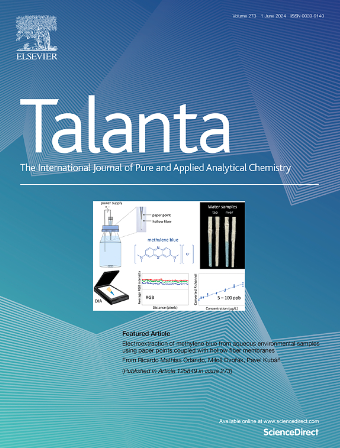Ergonomic and fully 3D–printed, activated, and modified electrochemical set–up for electroanalytical paracetamol detection
IF 5.6
1区 化学
Q1 CHEMISTRY, ANALYTICAL
引用次数: 0
Abstract
In this work, we manufactured the entire electrochemical configuration (all electrodes along with the ergonomic cell), which was 3D–printed using fused deposition modelling (FDM) technology. All electrodes were printed from carbon black/poly(lactic acid) (CB/PLA) filament, while the cell body was produced with neutral PLA. An activation process was conducted to enhance the electrochemical properties of all electrodes (working electrode (WE), counter electrode (CE), and reference electrode (RE)), which included immersion in dichloromethane followed by anodic, and cathodic treatment. The WE was only subjected to the activation process, providing the best output when the synergistic action of organic solvent and electrochemical electrode surface treatment were used. The novel aspects of this work originate from the applied electrode surface treatment, adjustment of all three electrodes' placement in an ergonomic and fully 3D printed cell, and finally, RE and CE properties adjustment. For the latter, the REs properties were defined by electrodeposition of silver particles further covered with AgCl, providing a stable and constant reference potential. The CE was made out of 3D–printed CB/PLA modified with platinum particles, which enhanced its electric conductivity. Even though, in both cases, the surface coverage was found to be nonhomogeneous the electrodes displayed desired properties, creating cheap substitutions to commercially available components. All electrodes were comprehensively inspected with a range of characterization techniques, including voltammetry, chronoamperometry, electrochemical impedance spectroscopy, scanning electron microscopy, optical profilometry, attenuated total reflectance Fourier–transform infrared spectroscopy, laser–induced breakdown spectroscopy along with surface wettability studies. The electrochemical behavior of the system, in the presence of a model redox probe, ferrocenemethanol, was analyzed using cyclic voltammetry. Finally, our fully 3D–printed sensing platform was assessed for paracetamol determination giving the limit of detection and limit of quantification to be 0.38 μM and 1.26 μM, respectively. The system was successfully applied to the determination of paracetamol in a pharmaceutical tablet using the standard addition method, confirming its suitability for quantitative analysis in complex sample matrices.

符合人体工程学和完全3d打印,激活和修改的电化学设置,用于电分析扑热息痛检测
在这项工作中,我们制造了整个电化学结构(所有电极以及符合人体工程学的电池),并使用熔融沉积建模(FDM)技术进行了3d打印。电极材料均为炭黑/聚乳酸(CB/PLA)长丝,胞体材料为中性聚乳酸。为了提高所有电极(工作电极(WE),对电极(CE)和参比电极(RE))的电化学性能,进行了一个活化过程,包括浸泡在二氯甲烷中,然后进行阳极和阴极处理。当有机溶剂和电化学电极表面处理协同作用时,WE只受活化过程的影响,输出效果最好。这项工作的新颖之处在于应用电极表面处理,调整所有三个电极在符合人体工程学和完全3D打印电池中的位置,最后调整RE和CE性能。对于后者,通过电沉积银粒子进一步覆盖AgCl来定义REs性能,从而提供稳定恒定的参考电位。CE是由3d打印的CB/PLA用铂颗粒改性制成的,这增强了其导电性。尽管在这两种情况下,表面覆盖都是不均匀的,但电极显示出了理想的性能,为商用组件创造了廉价的替代品。使用一系列表征技术对所有电极进行全面检查,包括伏安法、时安培法、电化学阻抗谱、扫描电子显微镜、光学轮廓法、衰减全反射傅立叶变换红外光谱、激光诱导击穿光谱以及表面润湿性研究。用循环伏安法分析了该体系在氧化还原探针二茂铁乙醇存在下的电化学行为。最后,我们的全3d打印传感平台对扑热息痛的检测进行了评估,检测限和定量限分别为0.38 μM和1.26 μM。该系统成功应用于标准加样法测定片剂中扑热息痛的含量,证实了该系统适用于复杂样品基质的定量分析。
本文章由计算机程序翻译,如有差异,请以英文原文为准。
求助全文
约1分钟内获得全文
求助全文
来源期刊

Talanta
化学-分析化学
CiteScore
12.30
自引率
4.90%
发文量
861
审稿时长
29 days
期刊介绍:
Talanta provides a forum for the publication of original research papers, short communications, and critical reviews in all branches of pure and applied analytical chemistry. Papers are evaluated based on established guidelines, including the fundamental nature of the study, scientific novelty, substantial improvement or advantage over existing technology or methods, and demonstrated analytical applicability. Original research papers on fundamental studies, and on novel sensor and instrumentation developments, are encouraged. Novel or improved applications in areas such as clinical and biological chemistry, environmental analysis, geochemistry, materials science and engineering, and analytical platforms for omics development are welcome.
Analytical performance of methods should be determined, including interference and matrix effects, and methods should be validated by comparison with a standard method, or analysis of a certified reference material. Simple spiking recoveries may not be sufficient. The developed method should especially comprise information on selectivity, sensitivity, detection limits, accuracy, and reliability. However, applying official validation or robustness studies to a routine method or technique does not necessarily constitute novelty. Proper statistical treatment of the data should be provided. Relevant literature should be cited, including related publications by the authors, and authors should discuss how their proposed methodology compares with previously reported methods.
 求助内容:
求助内容: 应助结果提醒方式:
应助结果提醒方式:


